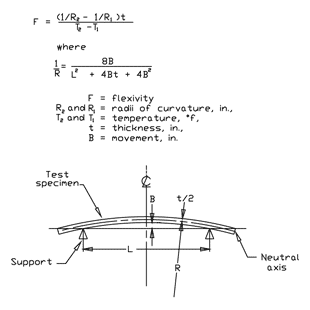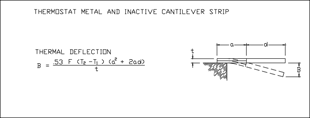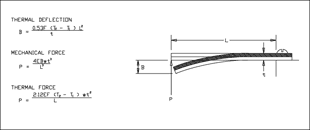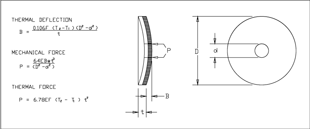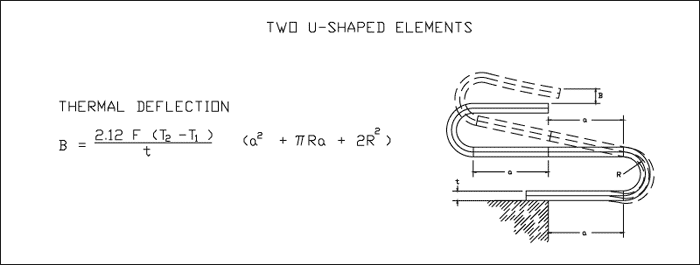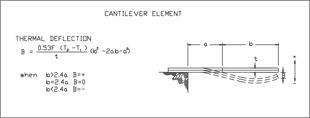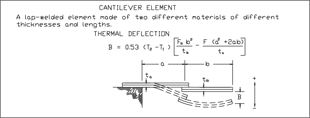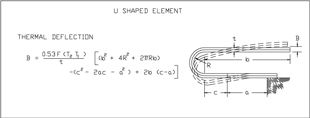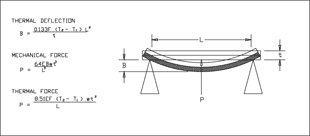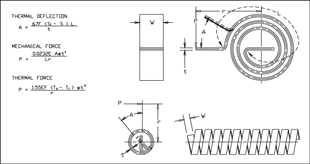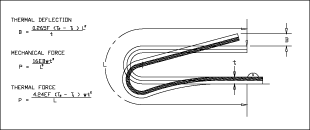Thermostat metal is a composite material, usually in the form of a strip or sheet, made up of two or more metallic layers having different coefficients of expansion. When permanently bonded together, these layers cause the material to change its curvature when subjected to a change in temperature. This change of curvature or bending in response to temperature change (flexivity) is a fundamental property of all thermostat metals.
If a thermostat metal element is initially straight or has an initial uniform curvature, the resulting curvature for uniform temperature change is uniform; that is, a true arc of constant radius is produced.

1. Two metal strips of identical length (at a given temperature) having high and low coefficients of thermal expansion.

2. When the temperature is raised, their relative lengths will change.

3. When the strips are bonded together, and the temperature raised, high expansion strip B will be under compression and low expansion strip A under tension.

4. These forces produce a moment which causes the element to bend in a uniform arc.
The change in curvature (bending) of a thermostat metal is directly proportional to the difference in the coefficient of expansion and the temperature change of the component strips, and inversely proportional to the thickness of the combined strips. The amount of bending is also affected by the ratio of the moduli of elasticity of the two strips and by their thickness ratio. A mathematical derivation of flexivity is shown in the following figure:
How It Is Made top
A wide variety of metals and alloys is used in the manufacture of thermostat metals. The components are joined in a true metallurgical bond made by special techniques. The result is a permanent bond that in many instances exceeds the strength of the separate metals.
Truflex thermostat metals are rolled to finish gauge on precision mills capable of holding very close tolerances. Intermediate annealing operations are performed in continuous strip annealing furnaces in reducing atmospheres. Pickling, cleaning and brushing procedures play an important part in the ultimate quality achieved.
Finishing operations include etching to permit quick identification of the high or low expansion side of the metal and in many cases of the material type. The low expansive side is identified unless otherwise specified by the customer. Finally, the thermostat metal is slit and flattened. A cold rolled surface is the standard finish. A uniform matte finish is available as is tension-leveled materials for special application.
Following these finishing operations, the material undergoes a rigid inspection to check its physical dimensions, flatness, hardness, electrical resistivity and flexivity.
The EMS thermostat metal parts department is equipped with the finest standard and special equipment for producing an infinite variety of parts and complex assemblies. Spiral and helix coils, flat blades, blanked and pierced members, U-shapes, and other intricate parts are made with exacting care to customers’ specifications.
Sizes Available top
Thickness: 0.003 to 0.125 inches
Width: 0.020 to 12 inches, in increments of 1/64 inch. As a general rule, the minimum width is three times the thickness.
Length: Strip is furnished in coils or flat cut lengths. Flat cut lengths are available up to 12 feet long. To minimize material waste, flat cut lengths should be ordered either in multiples of the part lengths or as straight random lengths and ends.
Hardnesstop
Since thermostat metals are composed of alloys which cannot normally be hardened by heat treating, hardness is developed by cold rolling. Elastic properties are also controlled by cold rolling. High hardness usually is associated with high elastic properties; therefore, a high degree of hardness is desirable in a thermostat metal element unless severe forming operations or sharp bends require softer material.
For any given thickness, thermostat metal is produced to a standard value of hardness unless otherwise specified by the customer. Softer material can be supplied if the forming or bending operations are too severe for this standard hardness. Material harder than standard can be supplied for thin pieces requiring spring properties. Rolling and process annealing of all thermostat metals are carefully controlled to maintain optimum grain size.
Most thermostat metal is used in relatively thin gauge and, because the high and low expansion sides (and sometimes a third intermediate layer) are each only a part of the total cross section, hardness testing should be performed on machines such as Vickers, Tukon, and Knoop which have very light loads and shallow penetration. Even with these instruments, it is difficult to determine accurately the hardness of material having a thickness of only a few thousandths of an inch. Refer to ASTM standard test methods.
Standard Dimensional Tolerancestop
| Thickness in inches | Tol. In inches |
| Under 0.005 | ± 0.0003 |
| 0.005 to 0.0099 inclusive | ± 0.00035 |
| 0.010 to 0.0149 inclusive | ± 0.0004 |
| 0.015 to 0.0199 inclusive | ± 0.0005 |
| 0.020 and over | ± 2.5% |
| Width in inches | Tol. In inches |
| Up to 1/2 | ± 0.003 |
| Over 1/2 to 1 inclusive | ± 0.004 |
| Over 1 to 3 inclusive | ± 0.008 |
| Over 3 to 6 inclusive | ± 0.010 |
| Over 6 | ± 0.030 |
| Length in feet | Tol. In inches |
| Up to 1 | ± 1/32 |
| Over 1 to 4 inclusive | ± 1/16 |
| Over 4 to 12 inclusive | ± 1/2 - 1/16 |
Edgewise camber – 9/32 in. max. In 3 feet
Edgewise camber is the deviation of a side edge from a straight line. It is measured by placing a 3 foot straightedge on the concave edge and measuring the distance from the center of the 3 foot straightedge to the strip edge.
Lengthwise flatness = .0005/thickness
Maximum in 3 inches at 75º F, where t is the thickness in inches. This
is measured by using a 3 inch straightedge, laying it up against either the
high expansion side or the low expansion side, whichever is concave, and
measuring the distance from center of the straightedge to the thermostat
metal.
Cantilever Beam with Inactive Tiptop
| Click above to enlarge |
Cantilever Beamtop
| Click above to enlarge |
Creep Disctop
| Click above to enlarge |
Double U-Shaped Elementtop
| Click above to enlarge |
RW Cantilever Beam (Edge Welded)top
| Click above to enlarge |
RW Cantilever Beam (Lap Welded)top
| Click above to enlarge |
RW Cantilever to U-Shaped Elementtop
| Click above to enlarge |
Simply Supported Beamtop
| Click above to enlarge |
Spiral Coiltop
| Click above to enlarge |
U-Shaped Elementtop
| Click above to enlarge |

